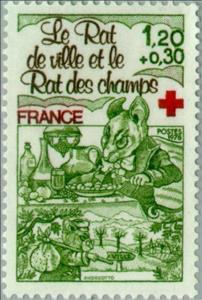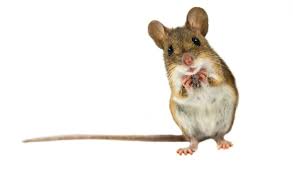Stamp: Fables of Jean de La Fontaine: The Rat City Rat and Field (France 1978)
Fables of Jean de La Fontaine: The Rat City Rat and Field (France 1978)
04 December (France ) within release Red Cross goes into circulation Stamp Fables of Jean de La Fontaine: The Rat City Rat and Field face value 1.20+0.30 French franc
| Stamp Fables of Jean de La Fontaine: The Rat City Rat and Field in catalogues | |
|---|---|
| Yvert et Tellier: | Yt:FR 2025 |
| Michel: | Mi:FR 2130 |
Stamp is vertical format.
Also in the issue Red Cross:
- Booklet - La Fontaine Fables face value 11;
- Stamp - The Hare and the turtle face value 1+0.25;
- Stamp - Fables of Jean de La Fontaine: The Rat City Rat and Field face value 1.20+0.30;
Stamp Fables of Jean de La Fontaine: The Rat City Rat and Field it reflects the thematic directions:
Mammals are any vertebrates within the class Mammalia (/məˈmeɪli.ə/ from Latin mamma "breast"), a clade of endothermic amniotes distinguished from reptiles (including birds) by the possession of a neocortex (a region of the brain), hair, three middle ear bones and mammary glands. All female mammals nurse their young with milk, secreted from the mammary glands. Mammals include the largest animals on the planet, the great whales. The basic body type is a terrestrial quadruped, but some mammals are adapted for life at sea, in the air, in trees, underground or on two legs. The largest group of mammals, the placentals, have a placenta, which enables the feeding of the fetus during gestation. Mammals range in size from the 30–40 mm (1.2–1.6 in) bumblebee bat to the 30-meter (98 ft) blue whale. With the exception of the five species of monotreme (egg-laying mammals), all modern mammals give birth to live young. Most mammals, including the six most species-rich orders, belong to the placental group. The largest orders are the rodents, bats and Soricomorpha (shrews and allies). The next three biggest orders, depending on the biological classification scheme used, are the Primates (apes and monkeys), the Cetartiodactyla (whales and even-toed ungulates), and the Carnivora (cats, dogs, seals, and allies).
A mouse (pl.: mice) is a small rodent. Characteristically, mice are known to have a pointed snout, small rounded ears, a body-length scaly tail, and a high breeding rate. The best known mouse species is the common house mouse (Mus musculus). Mice are also popular as pets. In some places, certain kinds of field mice are locally common. They are known to invade homes for food and shelter.
Fable is a literary genre defined as a succinct fictional story, in prose or verse, that features animals, legendary creatures, plants, inanimate objects, or forces of nature that are anthropomorphized, and that illustrates or leads to a particular moral lesson (a "moral"), which may at the end be added explicitly as a concise maxim or saying.
Animals are multicellular, eukaryotic organisms of the kingdom Animalia (also called Metazoa). All animals are motile, meaning they can move spontaneously and independently, at some point in their lives. Their body plan eventually becomes fixed as they develop, although some undergo a process of metamorphosis later on in their lives. All animals are heterotrophs: they must ingest other organisms or their products for sustenance.




